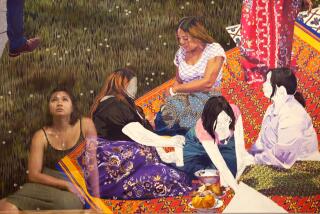U.S., Laotian Musicians Getting in Sync
- Share via
LONG BEACH — The first rehearsal began in silence.
Separated by a chasm of language and culture, the two groups of musicians clustered shyly at opposite sides of the room to unpack their instruments.
The musical collection at one end included a clarinet, saxophone, flute, drums, cello and electric keyboard. At the other end, the mixture was markedly different and included a handmade bamboo flute called a khene , a pair of finger cymbals called a chhaab and a pair of violin-like instruments made from coconuts called, respectively, so-eii and so-ou.
The Laotians played first. Sitting cross-legged on the floor, the classical musicians--many of them middle-aged men sporting coats and ties--spent a few minutes tuning up, then, seemingly without effort, launched into a haunting sing-song rendition of a traditional Laotian tune, “Champa Muong Lao.”
Later, the Americans--somewhat younger-looking in blue jeans and tennis shoes--did their bit: a sort of free-flowing New Wave jazz piece one described as “minimal groove-oriented free improvisation.”
But before the Americans had finished, the Laotians joined in. Immediately, the ice was broken. And so began a collaboration that, as far as they know, is the first of its kind anywhere: a marriage of classical Laotian folk music performed on handmade instruments with American improvisational jazz performed on the instruments of the West.
Joint Concert Set
The object: a joint concert to be performed May 7 at the Long Beach Museum of Art.
“We wanted to see what Western musicians could do with a world music that really hasn’t been absorbed in the West,” said Titus Levi, president of the California Outside Music Assn. Dedicated to promoting non-mainstream music, the 90-member association is sponsoring the cross-cultural musical effort with United Cambodian Community, a Long Beach support group for Southeast Asian refugees.
“We want to bridge the gap between their music and ours and their audience and ours,” Levi said.
Said Prany Sananikone, assistant director of United Cambodian Community: “If we don’t communicate in any other language, maybe we can communicate in music.”
The idea evolved out of the relationship between Levi and Sananikone, a native of Laos. Both residents of Long Beach, which has one of the largest concentrations of Southeast Asian refugees in the nation, the two men have been interested in the recent merging of Asian and Western art forms.
So, armed with a $2,000 grant from the private Brody Art Fund in Los Angeles, they put out the call. And last month, they held their first rehearsal with about nine Laotians (who play together frequently) and six Westerners--all members of a performing group called the Motor Totemist Guild.
That first gathering was largely spent listening to each other’s instruments and jamming together to get used to the sounds. At the end of the session, the two groups agreed to exchange cassette tapes by which to practice. And at the second rehearsal, held last week in a building owned by the Long Beach Department of Parks and Recreation, the group was joined by a handful of Cambodian musicians, as well as a crowd of Southeast Asian spectators who had driven all the way from San Diego for the event.
One of the difficulties in performing together, the musicians say, is that although Americans--even those who improvise--depend heavily on written music to reproduce specific tunes and rhythm; the musical traditions of Cambodia and Laos are largely handed down generation to generation without written notation. By transcribing to paper the music the Laotians gave them on tape, therefore, the Americans took a major step toward overcoming the differences dividing the two groups.
And by listening very carefully to each other’s sounds, the musicians say, they have begun a slow melding of their very divergent musical styles.
During the recent rehearsal, Lynn Johnston, a long-haired bookstore clerk from El Segundo, belted out a jazzed-up solo rendition of “Champa Muong Lao,” named after a Laotian flower. His bass clarinet was backed up by the quiet stringy strains of the traditional Asian ensemble. And when the Americans played a tune of their own, this time a classical dance-like piece by J.S. Bach, the Southeast Asians were visibly delighted at the chance to play along.
According to Judith Luther, development director for United Cambodian Community, the experiment is valuable for all concerned. “It expands the community of artists and musicians,” she said. “And it’s very helpful in bringing the refugees into the mainstream of the cultural life of the community. It also exposes young Americans to the history, value and richness of this Southeast Asian music.”
More to Read
Sign up for Essential California
The most important California stories and recommendations in your inbox every morning.
You may occasionally receive promotional content from the Los Angeles Times.










